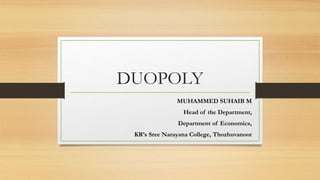
Cournot duopoly model equilibrium price output
- 1. DUOPOLY MUHAMMED SUHAIB M Head of the Department, Department of Economics, KR’s Sree Narayana College, Thozhuvanoor
- 2. Duopoly • Duopoly is a special type of Oligopoly, where only two Producers/Sellers exist in one market. • There exists Non-collusive oligopoly, means Sellers are completely independent. • The pricing and output of one firm will affect the another and may set a chain reaction. • Cournot and Edgeworth ignored mutual dependence but Chamberlin recognised the mutual dependence.
- 3. Cournot’s Duopoly Model • This is the earliest duopoly model, Developed by French Economist AUGUSTIN COURNOT in 1838. • He considered only two firms and they are owing Mineral well. • Each firm act on the assumption that its competition will not change its output and decides its own output so as to maximise his profit.
- 4. Major Assumptions • They are two independent sellers. • They produce and sell homogeneous products. • The number of buyers is large. • Each producer know the market demand for the product. • Cost of production is assumed to be zero. • Both firms have identical cost and identical demand.
- 5. Major Assumptions • Each firm decides their own quantity of output and ignores the role of rival. • Consider the supply curve of the rival is constant. • Entry of a new firm is blocked. • Both firms are aiming maximum profit. • Neither of them will fixes the price for its product, but each accepts the market demand price at which the product can be sold.
- 6. Price and Output under Duopoly • Initially, firm A is the only seller of mineral water in the market. • By assuming cost of production is zero, A charges 0P2 price and supply 0Q quantity. When MC=MR1, (MC is zero) • Here he charges monopoly price and Total Revenue is 0P2PQ
- 7. Price and Output under Duopoly • When firm B entered into the market, He got half of the market share for his product. • Firm B assumes that firm A will not change his price and output, then market available for B is PM of demand curve. • Here firm B supplies his product to the half of his market control (when MR2-MC(MC is zero)) • Firm B’s Price is 0P1 and output is QN and Total Revenue is QRP’N
- 8. Price and Output under Duopoly • Here both firm A&B are supplying half of the market share they have. • Firm B supplies only ¼ of the total market demand, (which is ½ x ½ = ¼ ). • The low price of firm B will compel firm A to reduce the Price, the firm A will restructure his Price and Output. • When firm A assumes that firm will continue its production at ¼ of market demand, the total market share available for firm B is ¾ , which is (1- ¼ = ¾ ). • To maximise his profit (firm A), he will supply half of the total market share available for him, (which is ½ x ¾ = 3/8 )
- 9. Price and Output under Duopoly • Here, firm A’s share will fall from ½ to 3/8. • Then, firm B also assumes that firm A will continue to supply 3/8 of the market demand, the total market demand available for firm B is 1- 3/8 = 5/8. • To maximise his profit (firm B) under new market condition B will supply half of his market demand, which is ½ x 5/8 = 5/16. • Then firm A will also change his Price and Output accordingly.
- 10. Price and Output under Duopoly • This process of action and reaction continues in successive periods, means firm A will loss his market share and firm B will gain till both firms get equal share in the market. • At the end of this process both firms will have 1/3 share of market demand. • The final price will be greater than the competitive price and less than the monopoly price. • In case of industry or market 1/3 portion of demand will be unsupplied. • In general, if there are ‘n’ firms in the industry, each will provide 1/n+1 of the market and the industry output will be n/n+1
- 11. Criticism • The model does not say how long the adjustment period will be. • The costless production is unrealistic. • This is closed model because it does not allow entry of firms. • This is a no-learning by doing model . • He assumed the supply of rival is fixed but here supply is repeatedly changing.